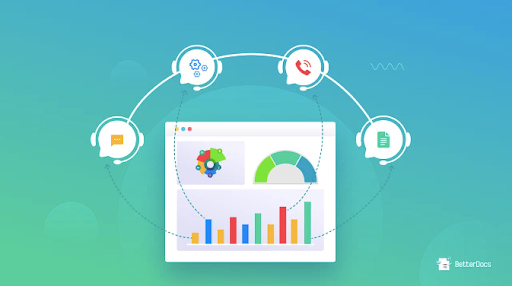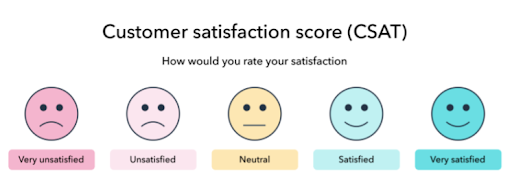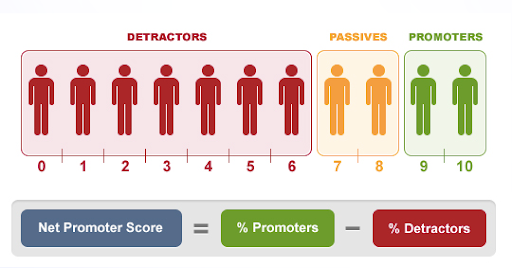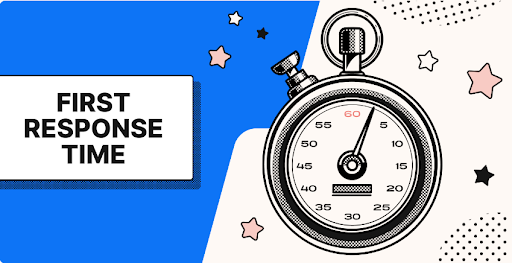
In today’s competitive business landscape, customer service is a critical determinant of success. More than just issue resolution, it’s about comprehending and enhancing the overall customer experience. Enter Customer Service Measurement Metrics—the compass that guides businesses through the intricacies of customer satisfaction, loyalty, and seamless interaction.

These customer service data metrics offer a magnifying glass into the customer journey, enabling businesses to craft a seamless story of satisfaction, loyalty, and success. As businesses increasingly recognize the relationship between exceptional customer service and overall success, Key Customer Service Metrics to Measure have become their core foundation. Metrics like Customer Satisfaction Metrics (CSAT), Net Promoter Score (NPS), and Customer Effort Score (CES) quantify customer satisfaction, providing actionable insights for decision-makers.
In this blog, we will discuss some important customer service metrics to track that you should monitor to better understand your customers and refine your service strategies.
Customer Experience (X-data) vs. Operational (O-data) Metrics
In the intricate landscape of customer service, understanding the difference between two fundamental types of metrics—experience (X-data) and operational (O-data)—is paramount. Let’s explore the significance of this differentiation and understand why these customer service performance metrics are indispensable for gaining comprehensive insights into customer interactions.
Experience (X-data) Metrics: Unveiling Customer Sentiment
Experience metrics focus on the qualitative aspects of customer interactions, uncovering the sentiment and emotions that underpin each engagement. Metrics like Customer Satisfaction (CSAT), Customer Effort Score (CES), and Net Promoter Score (NPS) fall under this category. CSAT gauges immediate satisfaction, CES measures the ease of a customer’s experience, and NPS in Customer Support provides insights into overall loyalty, making it one of the best customer service metrics to track.
Operational (O-data) Metrics: Streamlining Efficiency
Operational metrics revolve around the quantitative aspects of customer interactions, offering a pragmatic view of a business’s efficiency. Metrics like First Contact Resolution Rate in Customer Service, Average Response Time in Customer Service, and Customer Retention Metrics in Contact Center fall into this category. These service level agreement (SLA) metrics in customer support provide tangible data on the operational aspects of customer service, helping businesses streamline processes and enhance overall efficiency.

The Crucial Role of Customer Service Metrics in Gaining Valuable Customer Insights
Holistic Understanding of Customer Interactions
Both experience and operational metrics collectively provide a holistic understanding of customer interactions. While experience metrics reveal how customers feel about their journey, operational metrics like First Contact Resolution Rate reveal the efficiency and effectiveness of the service provided. Together, they paint a comprehensive picture, allowing businesses to address challenges, capitalize on strengths, and ultimately refine their customer service strategies using key customer service performance metrics.
Proactive Decision-Making and Continuous Improvement
The synergy between X-data and O-data empowers businesses to make informed, proactive decisions. By understanding the emotional landscape of customers (X-data) and the operational efficacy of services (O-data), businesses can implement targeted improvements. This amalgamation of customer care metrics fosters a culture of continuous improvement, ensuring that customer service evolves in tandem with ever-changing expectations.
Top 20 Customer Service Metrics to Track in 2025: Strategies & Examples
Key Customer Service Metrics to Measure: Driving Customer Satisfaction and Loyalty
As businesses strive for excellence in customer service, three pivotal customer service metrics to measure stand out as the pillars of gauging and enhancing the customer experience. These customer service measurement metrics provide valuable insights into customer satisfaction, loyalty, and overall performance, forming the foundation of effective customer service KPIs.
1. Customer Satisfaction (CSAT)

CSAT measures the immediate satisfaction of customers based on their recent interactions with a product, service, or support. Typically presented as a percentage, it provides a quick snapshot of how content customers are with their experience. As one of the best customer service metrics, CSAT serves as a real-time indicator, offering valuable insights into the effectiveness of customer service interactions.
A high CSAT score indicates contentment, while a lower score signals potential areas for improvement. It’s one of the most significant customer satisfaction metrics that businesses should track to optimize their service.
Strategies for improvement:
- Prioritize prompt and personalized communication to demonstrate responsiveness and individualized care.
- Proactively resolve issues by anticipating needs and offering efficient solutions, showcasing a commitment to customer well-being.
Example:
Wizr AI recently launched its CX Agent Assist platform. After integrating a short CSAT survey at the end of live agent interactions, the team observed an average satisfaction rating of 92%. By analyzing feedback where satisfaction dropped below 80%, they discovered delays in chatbot handovers. In response, they optimized their routing logic, leading to a 15% increase in CSAT within 30 days.
2. Customer Effort Score (CES)
Customer Effort Score (CES) focuses on the perceived ease or difficulty customers experience when interacting with a product or service. This customer service performance metric quantifies the perceived hassle, highlighting pain points in the customer journey.
A lower CES score indicates minimal effort on the customer’s part, signifying a smoother and more satisfying experience. Customer effort score in contact centers is essential in identifying and minimizing friction in the customer experience.
Strategies for improvement:
- Streamline processes.
- Enhance self-service options.
- Minimize customer touchpoints, which contributes to a reduced CES and improved customer care metrics.
Example:
Wizr AI client in the telecom industry noticed users had to go through 4 steps to troubleshoot a common billing issue. By deploying Wizr’s Auto Solve AI, they reduced it to 1 step using smart FAQs and proactive chatbot nudges. The CES dropped significantly, indicating less effort was needed from customers. This improvement led to a 25% increase in issue resolution speed and reduced inbound ticket volume by 18%.
3. Net Promoter Score (NPS)

Net Promoter Score (NPS) measures the likelihood of customers recommending a product or service to others. NPS is widely regarded as one of the key customer service performance metrics for gauging customer loyalty. Customers are categorized as Promoters, Passives, or Detractors, and the score is calculated by subtracting the percentage of Detractors from Promoters.
High NPS scores suggest a strong likelihood of customers advocating for the brand, while low scores may indicate potential churn. This makes NPS in customer support a crucial metric for understanding customer loyalty.
Strategies for improvement:
- Build strong relationships.
- Exceed expectations.
- Actively seek customer feedback to improve customer retention metrics in contact centers.
Incorporating these customer support metrics in contact centers ensures that businesses can not only track but also enhance their customer service performance metrics, driving satisfaction and long-term loyalty. Customer service metrics to measure like CSAT, CES, and NPS are essential in shaping proactive strategies that meet and exceed customer expectations, fostering growth and success in the customer service landscape.
Example:
Following the rollout of Wizr AI’s CX Control Room, a SaaS company used post-resolution surveys to track NPS. Promoters consistently mentioned the speed and accuracy of AI-powered support. Based on this feedback, the client launched a referral program targeting Promoters, which boosted NPS from 40 to 65 in two quarters and increased customer referrals by 30%.
Key Customer Service Metrics and Measurements for Operational Efficiency
Operational efficiency metrics play a pivotal role in shaping the effectiveness of support teams. Understanding and tracking key customer service metrics to measure operational efficiency is essential for improving customer service performance. Below, we explore some of the best customer service metrics to track.
4. Average Ticket Count
The average ticket count quantifies the number of service requests or issues handled within a specific timeframe. This customer service measurement metric serves as a barometer for workload management and provides insights into the efficiency of a support team.
Monitoring average ticket count helps businesses assess their capacity to address customer issues promptly. A balanced count indicates efficient service delivery, while a spike may signal potential challenges in maintaining service quality, directly impacting smart ticket routing and overall customer satisfaction metrics.
Strategies for improvement:
- Optimize average ticket count through automation
- Self-service encouragement
- Proactive issue communication
Example:
A leading HR tech firm implemented Wizr Cx AutoSolve to manage a high volume of daily support requests. By automating responses to common inquiries, they achieved a 54% deflection rate, significantly reducing the average number of tickets handled by human agents.
5. Service Level Agreement (SLA)

A service level agreement (SLA) metric outlines the agreed-upon timeframe within which customer inquiries or issues should receive a response. Achieving SLA metrics in customer support is crucial for meeting customer expectations and fostering a sense of reliability. These are essential customer support metrics in contact centers.
Meeting or exceeding SLA goals demonstrates a commitment to prompt and reliable service, reinforcing the brand’s reputation for responsiveness. Customers, in turn, feel valued and assured, knowing their concerns are acknowledged within specified timeframes.
Strategies for improvement:
- Implement workflow automation
- Regular monitoring
- Clear communication
- Continuous reviews for responsiveness enhancements
Example:
An enterprise utilizing Wizr Cx Control Room leveraged real-time monitoring and automated prioritization to improve SLA compliance. The system’s ability to analyze customer sentiment and issue categories enabled the support team to meet or exceed SLA targets consistently.
6. Ticket Backlog
The ticket backlog represents the accumulation of unresolved customer issues over time. Managing this backlog is essential for maintaining customer satisfaction metrics and operational efficiency.
A growing backlog can lead to delayed responses, impacting customer service performance metrics. Regularly addressing and resolving tickets ensures a more agile and responsive customer care team, contributing to overall operational efficiency.
Strategies for improvement:
- Implement prioritization techniques
- Adjust support team capacity
- Proactively resolve recurring issues using performance analytics
Example:
By deploying Wizr’s AI-driven ticket categorization and automated responses, a logistics SaaS firm managed to deflect 43% of support tickets. This proactive approach significantly reduced the ticket backlog and enhanced overall customer satisfaction.
Key Customer Service Response Time Metrics for Improved Efficiency
In the fast-paced world of customer service, response time is a vital benchmark that directly influences customer satisfaction metrics. Two key customer service KPIs — First Response Time and Average Response Time — serve as the gears that drive efficient communication and resolution in the contact center.
7. First Response Time

First response time measures the duration between a customer’s initial inquiry and the first meaningful response from a support agent. This metric is a critical customer service KPI that significantly impacts the overall customer experience and customer service performance metrics.
A swift first response demonstrates attentiveness and sets a positive tone for customer interaction. Monitoring and improving First Response Time ensures customers feel heard and valued from the outset, improving customer retention metrics in contact centers.
Strategies for Improvement:
- Utilize automated acknowledgment systems
- Implement prioritization techniques
- Provide training to support teams for quicker, yet thoughtful, initial responses
Example:
A fintech company integrated Wizr Cx Agent Assist to provide real-time information to support agents during customer interactions. This tool enabled agents to respond more quickly, reducing the first response time and improving the customer experience.
8. Average Response Time: Balancing Speed and Quality
Average response time calculates the average duration it takes for a support team to reply to customer inquiries. This customer support metric provides a holistic view of the overall responsiveness of the support system, highlighting customer support best practices that can enhance efficiency.
While efficiency is crucial, maintaining a balance between speed and the quality of responses is key. Achieving a low average response time without compromising the accuracy and helpfulness of responses indicates a well-optimized customer support operation.
Strategies for improvement:
- Invest in knowledge management systems
- Prioritize training for support agents
- Leverage automation for routine queries
- Ensure both speed and accuracy in responses
Example:
An e-commerce client used Wizr’s sentiment analysis and issue clustering to prioritize customer inquiries effectively. By addressing high-priority issues promptly, they reduced the average response time and enhanced customer satisfaction.
Key Resolution Metrics and Measurements for Customer Service Efficiency
The ability to swiftly and effectively resolve customer issues is a critical component of efficient customer service. Let’s explore the customer service metrics to measure and the strategies for improving them.
9. First-Contact Resolution Rate
The first-contact resolution rate in customer service gauges the percentage of customer issues resolved in the initial interaction with no additional follow-ups. This customer service performance metric reflects the efficiency and effectiveness of a support team in providing immediate solutions.
A high first-contact resolution rate correlates with heightened customer satisfaction metrics, indicating that support teams possess the expertise and resources to address and resolve issues promptly.
Strategies for improvement:
- Empower support agents with comprehensive training
- Access to knowledge bases
- Efficient communication tools to enhance the agent’s ability to resolve issues on the first interaction
Example:
A telecom provider employed Wizr’s predictive analytics to identify common customer issues and provided agents with AI-powered suggestions for resolutions. This strategy increased the first-contact resolution rate, leading to higher customer loyalty.
10. Average Ticket Resolution Time
The average ticket resolution time calculates the average duration it takes to resolve customer issues from the moment they are reported. This metric provides insights into the overall efficiency of the resolution process, highlighting the importance of automated ticket routing and smart ticket routing in enhancing resolution times..
While speed is crucial, maintaining balance with the precision of solutions is key. Achieving a low average ticket resolution time without compromising the quality of resolutions ensures a positive and efficient customer experience.
Strategies for Improvement:
Implement advanced ticketing systems, streamline workflows, and invest in continuous training to equip support teams with the skills necessary for swift and accurate issue resolution.
Example:
By automating routine inquiries with Wizr Cx AutoSolve, a SaaS company reduced the average ticket resolution time by 33%. This efficiency gain allowed support teams to focus on more complex issues, improving overall service quality.
11. Ticket Resolution Rate
The ticket resolution rate assesses the percentage of customer issues that are successfully resolved against the total number of reported issues. This customer service measurement metric indicates the support team’s effectiveness in closing the loop on customer concerns.
Strategies for Improvement:
- Ensure adequate support team capacity
- Leverage customer feedback for process enhancements
- Implement proactive measures to prevent recurring issues, ultimately improving the overall ticket resolution rate.
Example:
A contact center utilized Wizr’s AI-driven analytics to monitor agent performance and customer sentiment. This data-driven approach led to targeted training and process improvements, increasing the ticket resolution rate and customer satisfaction.
Essential Interaction Metrics to Measure in Customer Service
Understanding and optimizing customer interactions is vital for building lasting relationships. The following customer service KPIs provide insights into how efficiently and effectively businesses communicate with their customers:
12. Number of Interactions Per Ticket
The number of interactions per ticket metric quantifies the frequency of exchanges between a customer and the customer support team to resolve a single issue. This customer service metric to track offers insights into the efficiency and clarity of communication during issue resolution.
Minimizing the number of interactions per ticket is crucial for efficient issue resolution. It signifies streamlined communication and comprehensive resolution of customer concerns in fewer interactions, enhancing overall customer satisfaction metrics.
Strategies for improvement:
- Encourage support agents to ask thorough questions upfront
- Utilize detailed communication tools
- Foster a culture of clarity and completeness in customer interactions
Example:
Wizr AI’s Cx Agent Assist provides agents with real-time, contextually relevant information, enabling them to resolve customer issues more efficiently. This reduces the number of back-and-forth interactions required per ticket.
13. Preferred Communication Channel
The preferred communication channel metric involves observing and aligning with customer choices for communication channels—be it email, live chat, phone, or social media.
Acknowledging and optimizing preferred communication channels enhances the overall customer experience. Providing omni-channel customer support ensures that customers can engage through their preferred mediums, contributing to increased satisfaction and responsiveness.
Strategies to optimize channels:
- Implement systems that track and adapt to customer preferences
- Invest in platforms that facilitate seamless omni-channel support
- Regularly assess customer feedback regarding communication preferences
Example:
Wizr AI’s Cx Auto Solve allows businesses to deploy AI-powered chatbots across multiple channels, including web, mobile, and in-app messaging. This ensures customers can interact through their preferred communication mediums.
AI-Driven Customer Service Metrics for Enhanced Performance
The integration of Generative AI and other advanced technologies in customer service has become a game-changer for organizations looking to enhance their interactions with their clientele. AI-driven customer service metrics play a pivotal role in this transformation, offering businesses invaluable insights into their operations.
By leveraging AI, organizations can track and optimize various customer service metrics to measure, from automated interaction efficiency to sentiment analysis and beyond. These metrics not only enable businesses to streamline their processes but also contribute to a more personalized and responsive customer experience. Using AI in customer service empowers organizations to proactively address customer needs, predict issues, and tailor interactions, ultimately fostering stronger customer relationships.
Below are some of the metrics that advanced technologies like Generative AI can track with a high level of precision:
14. Customer Sentiment Analysis

Customer Sentiment Analysis involves deploying Natural Language Processing (NLP) algorithms to assess the emotional tone within customer interactions. It evaluates whether the sentiment is positive, negative, or neutral.
This customer service measurement metric profoundly impacts the customer experience, as businesses can use the insights gained to tailor their products, services, and communication strategies. By addressing pain points highlighted through sentiment analysis, companies can enhance overall customer satisfaction metrics and build stronger, more meaningful relationships with their customers.
Beyond customer satisfaction, sentiment analysis aids in crisis management. It allows businesses to quickly identify and address emerging issues, preventing potential reputation damage and showcasing a commitment to proactive customer care.
Example:
Wizr AI’s Cx Control Room utilizes generative AI to analyze customer support data, extracting sentiment insights to identify trends and potential issues before they escalate.
Strategies for Improvement:
- Integrate sentiment analysis tools to monitor customer emotions in real-time.
- Use insights to proactively address negative sentiments.
- Train support teams to handle interactions empathetically based on sentiment cues.
15. Agent Emotion Detection
Agent emotion detection employs advanced AI technologies, such as facial recognition and voice analysis, to discern the emotional state of customer service agents during interactions.
Monitoring agent emotions positively impacts both employee well-being and customer satisfaction metrics. By addressing stress or frustration in real-time, businesses can create a more positive work environment, leading to improved agent performance and, subsequently, enhanced customer experiences.
This customer care metric can be utilized for ongoing training and support. By analyzing patterns in agent emotions, businesses can identify areas for improvement, offer targeted training, and enhance overall team morale and effectiveness.
Example:
While specific implementations by Wizr AI aren’t detailed, integrating AI tools that monitor agent stress levels can enhance overall service quality by ensuring agents are supported and not overwhelmed.
Strategies for Improvement:
- Implement wellness programs based on emotion detection insights.
- Provide real-time support or breaks when high stress is detected.
- Use data to inform training and workload distribution.
16. Intelligent Query Routing

Intelligent query routing utilizes machine learning algorithms to categorize and prioritize customer queries, ensuring they are directed to the most suitable support channels or personnel.
The impact of intelligent query routing is significant in terms of operational efficiency. By optimizing resource allocation, businesses can reduce average response time in customer service, improve query resolution rates, and ultimately provide a more streamlined and effective customer service experience.
This metric can be expanded to include personalized routing, where historical customer data is considered. By directing queries based on a customer’s previous interactions or preferences, businesses can create a more personalized and efficient customer service experience.
Example:
Wizr AI’s platform employs machine learning to categorize and prioritize customer queries, ensuring they are directed to the most suitable support channels or personnel.
Strategies for Improvement:
- Continuously train routing algorithms with updated data.
- Monitor routing effectiveness and adjust parameters as needed.
- Incorporate customer feedback to refine routing logic.
17. First Contact Resolution Prediction
First contact resolution prediction involves leveraging historical data and machine learning to estimate the likelihood of resolving customer issues during the initial interaction.
Anticipating first contact resolution rate in customer service directly impacts customer satisfaction metrics. By increasing the likelihood of resolving issues in the first interaction, businesses can minimize customer effort, reduce frustration, and foster positive perceptions of their service.
This customer service KPI can be used to fine-tune support processes. By analyzing cases where first contact resolution is lower, organizations can identify areas for improvement, enhance agent training, and implement changes to increase overall efficiency.
Example:
Wizr AI’s predictive analytics capabilities allow businesses to anticipate the likelihood of resolving customer issues during the initial interaction, enabling proactive measures to enhance first contact resolution rates.
Strategies for Improvement:
- Analyze historical data to identify factors influencing first contact resolution.
- Equip agents with comprehensive knowledge bases.
- Implement decision trees to guide agents through complex issues.
18. Churn Prediction
Churn prediction utilizes predictive analytics and machine learning to analyze customer behavior and identify patterns indicative of potential churn, enabling businesses to proactively implement targeted retention strategies and foster long-term customer loyalty.
The impact of churn prediction is paramount for customer retention metrics in contact center. By identifying and addressing factors leading to churn, businesses can implement targeted retention strategies, such as personalized offers or proactive customer engagement, to significantly reduce customer attrition and enhance long-term loyalty.
Churn prediction can also inform product and service enhancements. By understanding the specific issues or preferences driving churn, businesses can make data-informed improvements, ensuring their offerings align more closely with customer expectations.
Example:
Wizr AI analyzes customer behavior and sentiment to identify patterns indicative of potential churn, allowing businesses to implement targeted retention strategies.
Strategies for Improvement:
- Develop personalized outreach programs for at-risk customers.
- Offer incentives or solutions tailored to customer concerns.
- Regularly review churn data to refine predictive models.
19. Customer Effort Prediction
Customer effort prediction employs machine learning to analyze interactions and predict the level of effort customers might need to expend to achieve their goals.
Minimizing customer effort directly impacts customer satisfaction metrics and loyalty. Positive customer sentiment can be achieved by predicting effort levels, allowing businesses to streamline processes, reduce friction points, and create a more user-friendly experience, contributing to increased customer loyalty and positive brand perception.
This customer service KPI can be instrumental in website and app design. By identifying high-effort touchpoints, businesses can optimize user interfaces, simplify navigation, and enhance overall usability, leading to a more enjoyable customer journey.
Example:
Wizr AI employs machine learning to analyze interactions and predict the level of effort customers might need to expend to achieve their goals, enabling businesses to streamline processes accordingly.
Strategies for Improvement:
- Simplify user interfaces based on effort predictions.
- Provide clear guidance and support throughout the customer journey.
- Continuously test and refine processes to reduce customer effort.
20. Customer Lifetime Value (CLV) Prediction
Customer Lifetime Value (CLV) prediction is a pivotal AI-driven customer service metric that focuses on estimating the total value a customer is likely to bring to a business over the entire duration of their relationship.
AI algorithms analyze historical data, including purchase patterns, frequency of interactions, and customer behavior, to forecast the potential value of each customer. By understanding the long-term profitability of individual customers, businesses can tailor their strategies to maximize the value derived from high-LTV customers.
This customer service data metric enables personalized marketing, loyalty programs, and targeted engagement efforts, ultimately contributing to increased customer retention and sustained revenue growth. CLV prediction empowers businesses to allocate resources efficiently, prioritize customer segments, and build lasting relationships that extend beyond individual transactions.
Example:
Wizr AI’s predictive analytics tools estimate the total value a customer is likely to bring over their relationship duration, aiding in strategic decision-making for customer engagement and retention.
Strategies for Improvement:
- Segment customers based on predicted CLV for targeted marketing.
- Invest more in high-CLV customer segments.
- Monitor CLV trends to adjust business strategies proactively.
21. Multichannel Engagement Effectiveness
Multichannel engagement effectiveness is a vital customer service KPI that assesses the success of AI-driven strategies in managing and optimizing customer interactions across various channels.
With the proliferation of communication platforms, businesses need to ensure a consistent and seamless customer experience regardless of the chosen channel—be it chat, email, social media, or others. AI algorithms analyze data from multiple touchpoints to evaluate how well a business engages with customers across various channels.
By measuring response times, content relevance, and customer satisfaction metrics across channels, businesses can identify areas for improvement, tailor their communication strategies, and ensure a unified and positive customer experience. This metric is instrumental in creating a cohesive omnichannel strategy, fostering customer loyalty, and staying responsive to the diverse preferences of modern consumers.
Example:
Wizr AI’s platform assesses the success of AI-driven strategies in managing and optimizing customer interactions across various channels, ensuring a consistent and seamless customer experience.
Strategies for Improvement:
- Ensure consistent messaging and support quality across all channels.
- Use analytics to identify and address channel-specific issues.
- Train support teams to handle multichannel interactions effectively.
Comprehensive KPI Table for Top 21 Customer Service Metrics in 2025
The following table provides a detailed overview of the top 21 customer service metrics that every business should measure in 2025 to enhance their customer support strategies. Each metric is paired with a key performance indicator (KPI) to track its effectiveness and actionable strategies for improvement. These metrics help businesses optimize their customer service operations, improve customer satisfaction, and drive business growth. Whether you’re using AI-powered customer support or traditional methods, these KPIs will guide your efforts to achieve better service outcomes and maintain a competitive edge in the industry.
| Metric | Description | Key Performance Indicator (KPI) | Strategies for Improvement |
|---|---|---|---|
| 1. Average Ticket Count | Tracks the number of service requests or issues handled in a specific time period. | Efficient service delivery and workload management. | – Automate repetitive tasks. – Encourage self-service. – Proactively communicate to reduce ticket volume. |
| 2. Service Level Agreement (SLA) | The time within which customer inquiries or issues should be responded to as agreed upon in the SLA. | Meet agreed response and resolution timeframes. | – Implement workflow automation. – Regularly monitor SLAs. – Foster clear communication and constant reviews for enhancements. |
| 3. Ticket Backlog | Measures the number of unresolved customer issues over time. | Timely resolution of outstanding issues. | – Prioritize urgent tickets. – Adjust team capacity as needed. – Use analytics to resolve recurring issues quickly. |
| 4. First Response Time (FRT) | Time taken from customer’s initial contact to the first response by a support agent. | A short response time correlates with higher customer satisfaction. | – Use automated acknowledgment systems. – Train agents for quicker responses. – Prioritize high-value issues. |
| 5. Average Response Time | The average time it takes for an agent to respond to a customer after the initial contact. | Fast responses without sacrificing quality. | – Implement knowledge management systems. – Invest in training for support agents. – Use automation for repetitive questions. |
| 6. First-Contact Resolution Rate (FCR) | Measures the percentage of issues resolved in the first interaction without follow-up. | High FCR indicates team efficiency and customer satisfaction. | – Empower agents with better training. – Provide comprehensive knowledge resources. – Equip agents with efficient communication tools. |
| 7. Average Ticket Resolution Time | The average time it takes to resolve a customer issue from when it was reported. | Speed and precision in solving issues. | – Implement an efficient ticketing system. – Streamline workflows. – Offer continuous training for agents. |
| 8. Ticket Resolution Rate | The percentage of customer issues that are resolved from the total number of reported issues. | High resolution rate equals better team effectiveness. | – Ensure the team is well-staffed. – Use customer feedback for continual improvement. – Prevent recurring issues by identifying patterns. |
| 9. Number of Interactions Per Ticket | Measures how many exchanges take place between the customer and support team for a single issue. | Fewer interactions per ticket indicate effective and clear communication. | – Ensure agents ask comprehensive questions early on. – Utilize detailed communication tools. – Foster clarity and completeness in each customer interaction. |
| 10. Preferred Communication Channel | Tracks the channels customers prefer to use for communication, such as email, live chat, or social media. | Streamlined communication using customer-preferred methods. | – Implement systems that track customer preferences. – Provide omni-channel support. – Regularly assess feedback for adjustments. |
| 11. Customer Sentiment Analysis | Uses NLP to analyze customer sentiment (positive, neutral, or negative) in interactions. | Insightful feedback to improve service quality and customer relationships. | – Use sentiment analysis tools to identify pain points. – Adjust services based on sentiment. – Address negative sentiment immediately. |
| 12. Agent Emotion Detection | Uses AI to monitor agents’ emotional state during interactions, affecting performance and satisfaction. | Higher morale correlates with higher customer satisfaction. | – Monitor agent stress levels. – Offer support and training based on emotional trends. – Identify areas for improvement and provide targeted support. |
| 13. Intelligent Query Routing | Uses AI and machine learning to direct customer queries to the appropriate team or channel. | Optimized resource allocation and reduced response time. | – Use machine learning to categorize issues. – Personalize routing based on customer history. – Reduce average response time with intelligent routing. |
| 14. First Contact Resolution Prediction | Uses historical data to predict whether a customer’s issue will be resolved during the first interaction. | Higher likelihood of issue resolution in the first interaction. | – Use AI to analyze past cases for resolution prediction. – Focus on improving first-touch resolution rates by enhancing agent skills. |
| 15. Churn Prediction | Predicts which customers are likely to leave, based on behavior and interactions. | Proactive retention of high-risk customers. | – Implement targeted retention strategies. – Analyze at-risk customer behavior. – Tailor engagement efforts based on churn predictions. |
| 16. Customer Effort Prediction | Uses machine learning to predict how much effort a customer will have to exert to resolve an issue. | Minimizing effort for customers improves satisfaction and loyalty. | – Streamline customer processes. – Simplify touchpoints to enhance customer experience. – Optimize website and app interfaces. |
| 17. Customer Lifetime Value (CLV) | Predicts the total value a customer will bring over the entire relationship period. | Maximize CLV by focusing on high-value customers. | – Focus marketing on high-LTV customers. – Implement loyalty programs. – Offer personalized engagement to retain valuable customers. |
| 18. Multichannel Engagement Effectiveness | Measures the success of customer service across multiple channels, ensuring a consistent experience. | Seamless customer experience across all platforms. | – Monitor customer engagement metrics across channels. – Analyze response time and satisfaction by channel. – Implement a cohesive omnichannel strategy. |
| 19. Average Handling Time (AHT) | Measures the average time it takes for an agent to handle a customer’s issue, from initial contact to resolution. | Balance speed with quality of service. | – Provide training to reduce handling time. – Leverage automation for simple queries. – Streamline workflows to minimize AHT without sacrificing customer experience. |
| 20. Customer Satisfaction Score (CSAT) | A direct measure of customer happiness based on survey responses after an interaction. | Customer feedback on how satisfied they are with the service received. | – Use follow-up surveys to measure CSAT. – Address negative feedback quickly. – Implement changes based on survey insights. |
| 21. Net Promoter Score (NPS) | Measures how likely customers are to recommend your service to others, gauging customer loyalty. | High NPS signifies strong customer loyalty. | – Actively seek and analyze NPS feedback. – Implement improvements based on negative responses. – Reward and engage loyal customers to boost NPS. |
Conclusion
Understanding and monitoring key customer service metrics to measure is essential for any successful business aiming to deliver exceptional customer experiences. By using advanced technologies like Generative AI to assess these customer service KPIs, businesses can identify areas for improvement, enhance efficiency, and build stronger connections with their customer base. The insights gained from these metrics not only empower teams to make data-driven decisions but also contribute to the overall growth and success of the organization.
FAQs
1. What are the most important customer service metrics to track in 2025?
In 2025, the most important customer service metrics to track include first response time, customer satisfaction (CSAT), net promoter score (NPS), first contact resolution (FCR), and customer sentiment analysis. These KPIs help companies understand service quality, agent performance, and customer experience in real time. Tools like Wizr AI support businesses with AI-powered customer service analytics, helping improve metrics like customer effort score and churn prediction.
2. How does customer sentiment analysis improve customer service?
Customer sentiment analysis, powered by AI, helps businesses understand customer emotions in real-time, allowing them to proactively address negative feedback. Using tools like Wizr AI’s CX Control Room, companies can identify trends in sentiment and respond promptly to enhance customer experience and reduce churn.
3. Why is First Contact Resolution (FCR) important for customer service?
First Contact Resolution (FCR) is crucial as it measures how effectively issues are resolved during the first interaction. This metric directly impacts customer satisfaction and efficiency. With platforms like Wizr AI’s CX Agent Assist, businesses can empower agents with real-time information, increasing the likelihood of resolving issues on the first contact.
4. What is predictive analytics in customer service, and why does it matter?
Predictive analytics in customer service uses AI to analyze customer behavior and predict future actions like churn or support needs. By leveraging tools like Wizr AI, businesses can forecast customer lifetime value (CLV), improve retention, and optimize their service strategies to stay ahead of customer needs.
5. How do AI-powered solutions improve response times in customer service?
AI-powered solutions like Wizr AI’s CX Auto Solve drastically reduce response times by automating routine inquiries and providing agents with instant access to relevant information. This leads to faster resolutions, fewer interactions per ticket, and higher customer satisfaction scores.
About Wizr AI
Wizr AI is an Advanced Enterprise AI Platform that empowers businesses to build Autonomous AI Agents, AI Assistants, and AI Workflows, enhancing enterprise productivity and customer experiences. Our CX Control Room leverages Generative AI to analyze insights, predict escalations, and optimize workflows. CX Agent Assist AI delivers Real-Time Agent Assist, boosting efficiency and resolution speed, while CX AutoSolve AI automates issue resolution with AI-Driven Customer Service Automation. Wizr Enterprise AI Platform enables seamless Enterprise AI Workflow Automation, integrating with data to build, train, and deploy AI agents, assistants, and applications securely and efficiently. It offers pre-built AI Agents for Enterprise across Sales & Marketing, Customer Support, HR, ITSM, domain-specific operations, Document Processing, and Finance.
Experience the future of enterprise productivity—request a demo of Wizr AI today.
